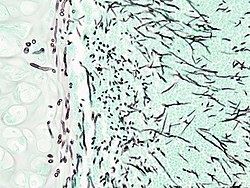Aspergillosis
| Aspergillosis | |
|---|---|
 |
|
| Pulmonary invasive aspergillosis in a patient with interstitial pneumonia (autopsy material), using Grocott's methenamine silver stain | |
| Pronunciation | |
| Classification and external resources | |
| Specialty | Infectious disease |
| ICD-10 | B44 |
| ICD-9-CM | 117.3 |
| MedlinePlus | 001326 |
| eMedicine | med/174 |
| Patient UK | Aspergillosis |
| MeSH | D001228 |
Aspergillosis is the name given to a wide variety of diseases caused by infection by fungi of the genus Aspergillus. The majority of cases occur in people with underlying illnesses such as tuberculosis or chronic obstructive pulmonary disease (COPD), but with otherwise healthy immune systems. Most commonly, aspergillosis occurs in the form of chronic pulmonary aspergillosis (CPA), aspergilloma or allergic bronchopulmonary aspergillosis (ABPA). Some forms are intertwined; for example ABPA and simple aspergilloma can progress to CPA.
Other, non-invasive manifestations include fungal sinusitis (both allergic in nature and with established fungal balls), otomycosis (ear infection), keratitis (eye infection) and onychomycosis (nail infection). In most instances these are less severe, and curable with effective antifungal treatment.
People with deficient immune systems—such as patients undergoing hematopoietic stem cell transplantation, chemotherapy for leukaemia, or AIDS—are at risk of more disseminated disease. Acute invasive aspergillosis occurs when the immune system fails to prevent Aspergillus spores from entering the bloodstream via the lungs. Without the body mounting an effective immune response, fungal cells are free to disseminate throughout the body and can infect major organs such as the heart and kidneys.
...
Wikipedia
